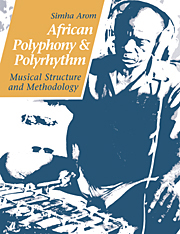Book contents
- Frontmatter
- Contents
- List of illustrations
- Foreword by György Ligeti
- Preface
- Acknowledgements
- BOOK I THE MUSIC OF THE CENTRAL AFRICAN REPUBLIC
- BOOK II AFRICAN POLYPHONIC MUSIC
- Introduction
- 1 A classification of African polyphonies
- 2 Previous studies: the present state of the subject
- BOOK III TECHNICAL TOOLS: METHODS OF RECORDING POLYPHONIC MUSIC FOR TRANSCRIPTION
- BOOK IV THEORETICAL TOOLS
- BOOK V THE ORGANISATION OF TIME IN AFRICAN MUSIC
- BOOK VI STRUCTURAL PRINCIPLES AND THEIR APPLICATION
- Conclusion
- Bibliography
1 - A classification of African polyphonies
Published online by Cambridge University Press: 27 January 2010
- Frontmatter
- Contents
- List of illustrations
- Foreword by György Ligeti
- Preface
- Acknowledgements
- BOOK I THE MUSIC OF THE CENTRAL AFRICAN REPUBLIC
- BOOK II AFRICAN POLYPHONIC MUSIC
- Introduction
- 1 A classification of African polyphonies
- 2 Previous studies: the present state of the subject
- BOOK III TECHNICAL TOOLS: METHODS OF RECORDING POLYPHONIC MUSIC FOR TRANSCRIPTION
- BOOK IV THEORETICAL TOOLS
- BOOK V THE ORGANISATION OF TIME IN AFRICAN MUSIC
- BOOK VI STRUCTURAL PRINCIPLES AND THEIR APPLICATION
- Conclusion
- Bibliography
Summary
INTRODUCTION
For many European musicologists, the word ‘polyphony’ describes a technique of the art of composition that belongs to their tradition alone. In the Western world, polyphony dates from the end of the first thousand years AD. It blossomed in the school of Notre-Dame of Paris around 1200, particularly in the organa of Perotin. It has since been established, in various forms, as one of the fundamental techniques of composition in European Art music, of which it was at one time the principal characteristic.
If the idea of polyphony is accepted in such a narrow sense, it cannot be applied to the music of any other civilisation, whether this be the orchestral ensembles of Bali or the choral and instrumental ensembles of Black Africa. Let us quote the radical crew expressed by Pierre Boulez in the Encyclopédie de la Musique published by Fasquelle:
The evolution of music in a polyphonic direction is a cultural phenomenon that belongs exclusively to the civilisation of Western Europe. In the various musical civilisations that preceded it, even those that rested on theoretically solid foundations, true polyphony, the principle of independent part movement, which characterises Western counterpoint, is not observable therein whatever certain musicologists say. In so-called exotic musics, one frequently finds […] all kinds of superimposition but these are caused by simultaneous relationships in time, and not independent movement of parts.
(Enc. Fasquelle 1958: 1, 584, ‘Contrepoint’)This typically ethnocentric opinion differs fundamentally from that of Jacques Chailley who, in the Larousse Dictionnaire de la Musique, recalls that ‘until very recently, polyphony was regarded as an invention of the learned Western world, where it was first mentioned in a treatise attributed to Hucbald in the ninth century.’
- Type
- Chapter
- Information
- African Polyphony and PolyrhythmMusical Structure and Methodology, pp. 34 - 44Publisher: Cambridge University PressPrint publication year: 1991



